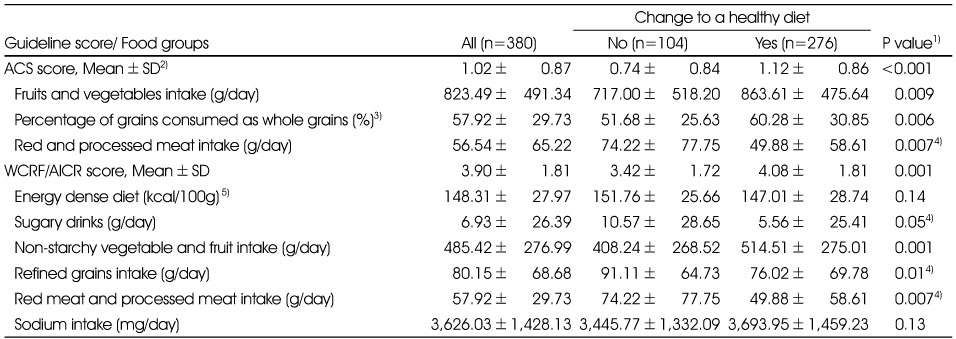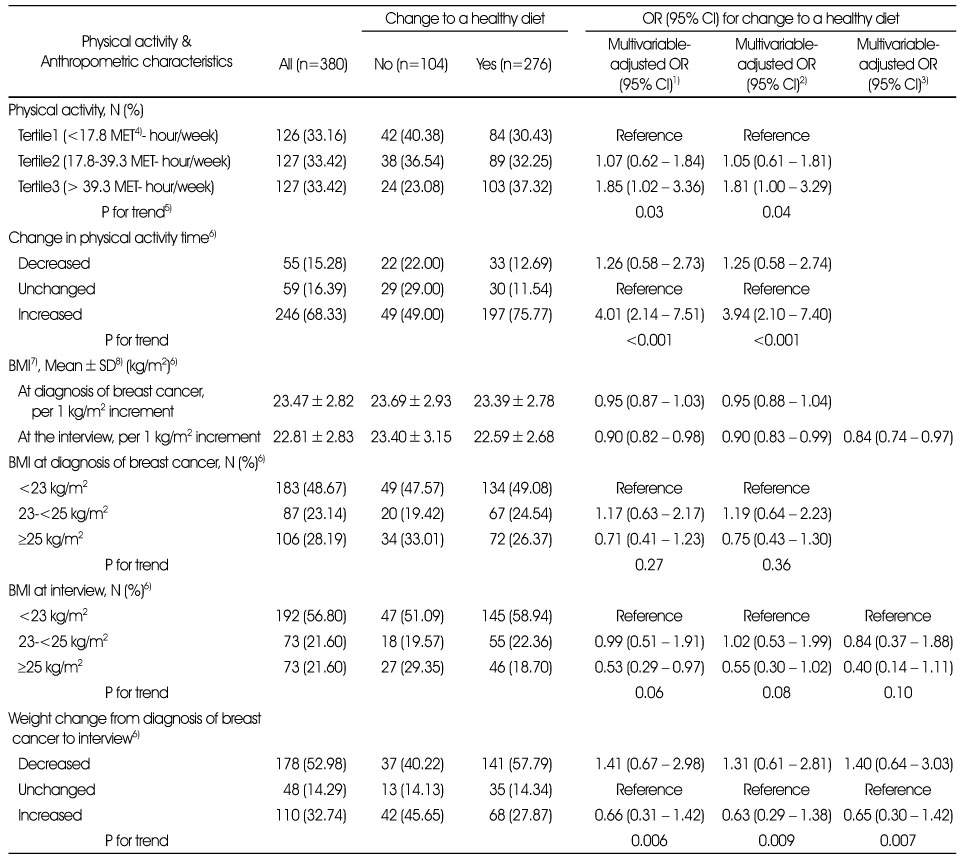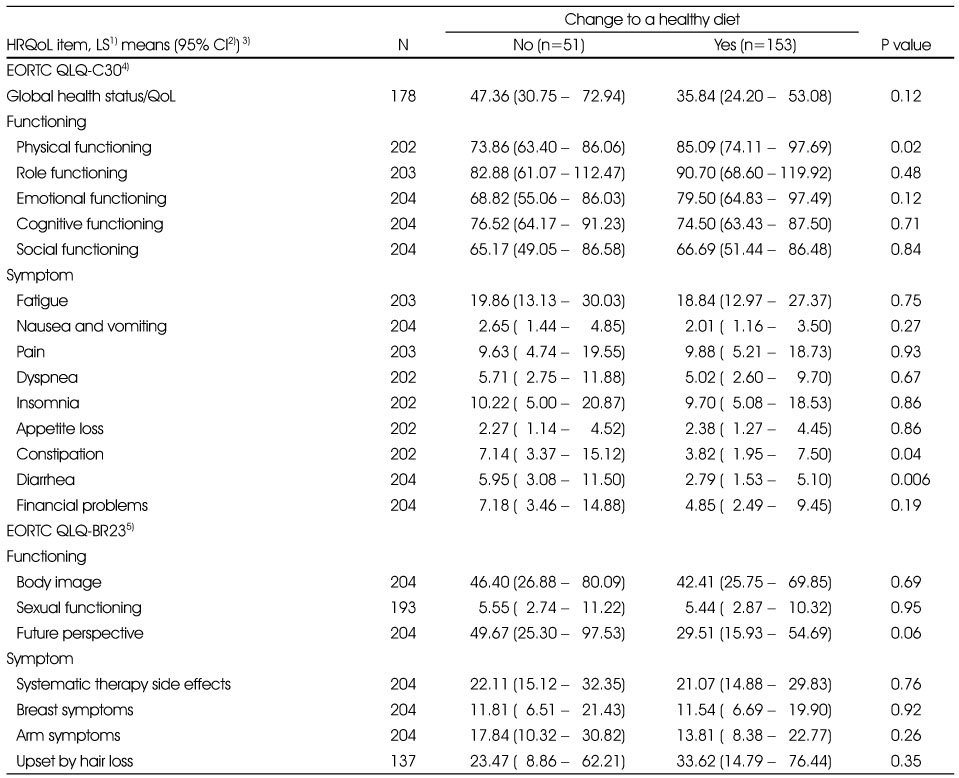Articles
- Page Path
- HOME > Korean J Community Nutr > Volume 21(6); 2016 > Article
-
Research Article
- Dietary Changes After Breast Cancer Diagnosis: Associations with Physical Activity, Anthropometry, and Health-related Quality of life Among Korean Breast Cancer Survivors
-
Sihan Song, Hyun Jo Youn, So-Youn Jung, Eunsook Lee, Zisun Kim, Jihyoung Cho, Young Bum Yoo, Hyeong-Gon Moon, Dong-Young Noh, Jung Eun Lee

-
Korean Journal of Community Nutrition 2016;21(6):533-544.
DOI: https://doi.org/10.5720/kjcn.2016.21.6.533
Published online: December 31, 2016
1Department of Food and Nutrition, College of Human Ecology, Sookmyung Women's University, Seoul, Korea.
2Department of Surgery, Chonbuk National University Medical School, Jeonju, Korea.
3Center for Breast Cancer, National Cancer Center, Goyang, Korea.
4Department of Surgery, Soonchunhyang University College of Medicine, Bucheon, Korea.
5Department of Surgery, Keimyung University School of Medicine, Daegu, Korea.
6Department of Surgery, Konkuk University School of Medicine, Seoul, Korea.
7Breast Care Center, Seoul National University Hospital, Seoul, Korea.
8Department of Surgery and Cancer Research Institute, Seoul National University College of Medicine, Seoul, Korea.
9Department of Food and Nutrition, College of Human Ecology, Seoul National University, Seoul, Korea.
- Corresponding author: Jung Eun Lee. Department of Food and Nutrition, Seoul National University, College of Human Ecology, 1 Gwanak-ro, Gwanak-gu, Seoul 08826, Korea. Tel: (02) 880-6834, Fax: (02) 880-0305, jungelee@snu.ac.kr
Copyright © 2016 The Korean Society of Community Nutrition
This is an Open-Access article distributed under the terms of the Creative Commons Attribution Non-Commercial License (http://creativecommons.org/licenses/by-nc/3.0/) which permits unrestricted non-commercial use, distribution, and reproduction in any medium, provided the original work is properly cited.
- 994 Views
- 1 Download
- 4 Crossref
Figure & Data
REFERENCES
Citations

- Development and Effects of a Smartphone Application to Improve Self-Management in Workers Who Underwent Thyroid Cancer Surgery
Myoyoun Kim, Seon Young Hwang
Cancer Nursing.2025;[Epub] CrossRef - Health-Related Behaviors of Middle-Aged Cancer Survivors: A Comparative Study with Matched Non-Cancer Controls Using the Korea National Health and Nutrition Examination Survey VI–VII (2013–2018) Data
Mi Lee KIM, Ju Ri JEONG, Yu Ri CHOE
Korean Journal of Health Promotion.2025; 25(1): 20. CrossRef - Cancer survivor's dietary safety management awareness and competency type
Yun Hwa Kim
Journal of Nutrition and Health.2020; 53(5): 532. CrossRef - Health-related Quality of Life and Its Related Factors among Cancer Survivors and General Adults: Focusing on Lifestyle Behaviors and Mental Health
Eun A Song, Youngran Kweon, Yoon Young Hwang, Minjeong An
Korean Journal of Adult Nursing.2020; 32(4): 385. CrossRef
Demographic, clinical and lifestyle characteristics of study participants according to change to a healthy diet after diagnosis of breast cancer
1) Log transformed t-test was used for continuous variables and chi-square test was used for categorical variables.
2) SD: standard deviation
3) Number of participants did not equal to 380 because some participants did not provide the relevent information.
4) AJCC: American Joint Committee on Cancer
5) BMI: body mass index
6) NA: Not available
7) Fisher exact test was used.
Adherence score of American Cancer Society (ACS) or World Cancer Research Fund/American Institute for Cancer Research (WCRF/AICR) guidelines and intake of food groups at interview according to change to a healthy diet after diagnosis of breast cancer (n=380)
1) T-test was used for comparing two groups.
2) SD: standard deviation
3) Among 380, one participant was excluded.
4) Wilcoxon-Mann-Whitney test was used for comparing two groups.
5) Energy dense diet denotes energy intake per amount of total food intake (kcal per 100 g).
Odds ratio (OR) and 95% confidence interval (CI) for change to a healthy diet by physical activity and anthropometric measures (n=380)
1) Models were adjusted for age (year; continuous), energy intake (kcal/day; continuous), stage of breast cancer (I, II, III), and alcohol intake (never, former, current).
2) Models were adjusted for age (year; continuous), energy intake (kcal/day; continuous), stage of breast cancer (I, II, III), and alcohol intake (never, former, current). For physical activity, BMI at diagnosis (<23, 23-<25, ≥25 kg/m2) was additionally adjusted. For BMI or weight change, physical activity (MET hours/week, tertile) was additionally adjusted.
3) Models were adjusted for age (year; continuous), energy intake (kcal/day; continuous), stage of breast cancer (I, II, III), and alcohol intake (never, former, current), physical activity (MET hours/week, tertile), and BMI at diagnosis (<23, 23-<25, ≥25 kg/m2).
4) MET: metabolic equivalent task.
5) P for trend was calculated by assigning median or ordinal value as continuous variable.
6) Number of participants did not equal to 380 because some participants did not provide the relevant information.
7) BMI: body mass index
8) SD: standard deviation
Health-related quality of life (HRQoL) scores according to change to a healthy diet after diagnosis of breast cancer (n=204)
1) LS means: least-squares means
2) 95% CI: 95% confidence interval
3) Models were adjusted for age (year; continuous), energy intake (kcal/day; continuous), body mass index at diagnosis (<23, 23-<25, ≥25 kg/m2), marital status (married or cohabitation, unmarried or divorced or widowed), current menopausal status (premenopausal, postmenopausal), education level (middle school or below, high school, and college or above), stage of breast cancer (I, II, III), time from breast cancer surgery (6 month-<1 year, 1 year-<5 years, ≥5 years), and alcohol intake (never, former, current).
4) EORTC QLQ-30: EUROPEAN Organization for Research and Treatment of Cancer Quality of Life Questionnaire Core 30
5) BR23: breast cancer module
1) Log transformed t-test was used for continuous variables and chi-square test was used for categorical variables. 2) SD: standard deviation 3) Number of participants did not equal to 380 because some participants did not provide the relevent information. 4) AJCC: American Joint Committee on Cancer 5) BMI: body mass index 6) NA: Not available 7) Fisher exact test was used.
1) T-test was used for comparing two groups. 2) SD: standard deviation 3) Among 380, one participant was excluded. 4) Wilcoxon-Mann-Whitney test was used for comparing two groups. 5) Energy dense diet denotes energy intake per amount of total food intake (kcal per 100 g).
1) Models were adjusted for age (year; continuous), energy intake (kcal/day; continuous), stage of breast cancer (I, II, III), and alcohol intake (never, former, current). 2) Models were adjusted for age (year; continuous), energy intake (kcal/day; continuous), stage of breast cancer (I, II, III), and alcohol intake (never, former, current). For physical activity, BMI at diagnosis (<23, 23-<25, ≥25 kg/m2) was additionally adjusted. For BMI or weight change, physical activity (MET hours/week, tertile) was additionally adjusted. 3) Models were adjusted for age (year; continuous), energy intake (kcal/day; continuous), stage of breast cancer (I, II, III), and alcohol intake (never, former, current), physical activity (MET hours/week, tertile), and BMI at diagnosis (<23, 23-<25, ≥25 kg/m2). 4) MET: metabolic equivalent task. 5) P for trend was calculated by assigning median or ordinal value as continuous variable. 6) Number of participants did not equal to 380 because some participants did not provide the relevant information. 7) BMI: body mass index 8) SD: standard deviation
1) LS means: least-squares means 2) 95% CI: 95% confidence interval 3) Models were adjusted for age (year; continuous), energy intake (kcal/day; continuous), body mass index at diagnosis (<23, 23-<25, ≥25 kg/m2), marital status (married or cohabitation, unmarried or divorced or widowed), current menopausal status (premenopausal, postmenopausal), education level (middle school or below, high school, and college or above), stage of breast cancer (I, II, III), time from breast cancer surgery (6 month-<1 year, 1 year-<5 years, ≥5 years), and alcohol intake (never, former, current). 4) EORTC QLQ-30: EUROPEAN Organization for Research and Treatment of Cancer Quality of Life Questionnaire Core 30 5) BR23: breast cancer module

 KSCN
KSCN




 PubReader
PubReader Cite
Cite


